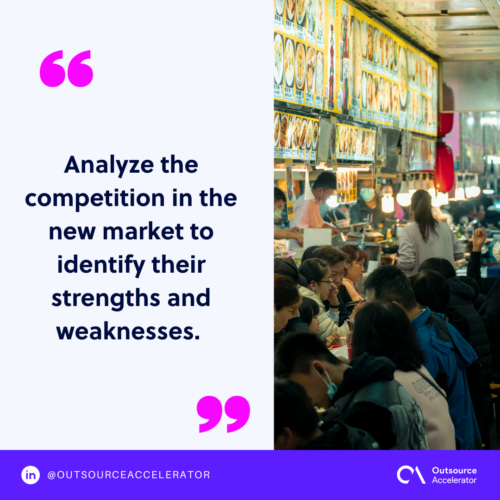Market development: A strategic approach for business expansion

Business expansion comes with inherent risks. But with the right strategies, companies can minimize risks and increase their chances of success.
One effective strategy is market development. According to the father of strategic management, Igor Ansoff, it is one of the four major strategies that help businesses grow.
By venturing into new markets, market development allows firms to broaden their perspective.
This guide will explore the stages, benefits, challenges, and essential steps to creating successful market development strategies. Let’s dive in and discover how it can propel your organization forward.
What is market development?
Market development identifies and develops new markets for existing products or services. It is a strategic approach to business expansion that requires research, analysis, and planning.
Market development identifies and leverages untapped markets and opportunities to increase revenue and market share. It also helps reduce reliance on existing markets and diversifies revenue streams.

Market development vs. Market penetration
Market development is often confused with market penetration. While both strategies involve business expansion, they differ significantly in approach.
Market penetration increases the sales of existing products or services in existing markets. In contrast, market development involves expanding into new markets by introducing existing products or services.
To illustrate the difference between these strategies, let’s look at an example:
Imagine a local coffee shop with a loyal customer base in one neighborhood. The coffee shop wants to increase its market share in that neighborhood.
It could adopt a market penetration strategy by launching a loyalty program to incentivize customers to return.
If the coffee shop wants to expand into a new neighborhood, it can use a market development strategy. This involves finding new locations, identifying potential customers, and launching targeted marketing campaigns.
4 stages of market development
Market development strategies usually involve four stages:
1. Define the target market
The first stage of market development involves defining the market.
Enterprises need to identify and understand the market they wish to enter. They need to consider the market’s size, demographics, and potential for growth.
This helps determine whether it’s viable and worth pursuing.
2. Conduct thorough research
After defining the target market, businesses conduct thorough research to analyze the market viability, competition intensity, and growth potential.
This stage involves gathering data on customer demand, target audience preference, and regulatory frameworks to determine the growth path.
3. Make decisions
Firms then make appropriate market entry, pricing, promotions, and advertising decisions. Companies must assess the culture and legal environment to understand the product-market fit.
4. Devise a plan
The business creates a comprehensive plan once the decisions are made and the action plan is finalized.
This involves planning for market entry and designing sales strategies that target the new market. Companies must determine the marketing channels and advertising media that serve them best.
Benefits of market development strategies
Market development can bring several benefits, including:
- Diversification of revenue streams. By expanding into new markets, businesses reduce their reliance on a single market. This helps them withstand market fluctuations and economic uncertainties.
- Increased brand visibility. Entering new markets exposes the brand to a broader audience, increasing brand visibility, reputation, and customer loyalty.
- Utilization of existing resources. Market development leverages existing products or services, core competencies, and resources. This allows companies to capitalize on their strengths and minimize additional investments.
- Long-term growth potential. Successfully entering and establishing a presence in new markets can lead to sustained growth opportunities in the long term.
Challenges to successful market development
While market development presents exciting growth opportunities, it comes with its own set of challenges:
- Cultural differences. Entering a new market often means dealing with different cultures, languages, and business practices. Understanding and adapting to these differences can be a significant challenge.
- Regulatory complexities. Each market has its own set of regulations and legal requirements. Navigating through complex regulatory landscapes can be time-consuming and costly.
- Competition. New markets may already have established players with loyal customer bases. It can be daunting to compete with them and gain market share.
- Resource constraints. Expanding into new markets needs extra resources, like manpower, capital, and technology. It might be difficult to ensure enough resources are available to support the expansion.

Examples of market development strategies
A market development plan can be used in different ways. Here are some examples of where it can apply:
Geographic expansion
One common market development approach is geographic expansion. It’s where a business enters new areas to target untouched markets.
For example, a restaurant chain may expand its operations to a different city or country to reach new customers and increase its market share.
Upselling to existing customers
Upselling involves offering additional products or services to current customers. This encourages them to make repeat purchases and increase their overall value.
For instance, a telecommunications company might offer existing clients upgraded data plans or premium services. Therefore, market development drives revenue growth through upselling.
Enticing non-users
Market development can target non-users of a product or service and convert them into customers.
Companies can achieve this by focusing their marketing efforts on the unique needs and pain points of non-users.
For example, a fitness app may develop targeted campaigns to attract individuals not currently engaged in fitness activities. They do so by highlighting the benefits and convenience of their platform.
Attracting competitors’ customers
Another way is to attract customers away from competitors. Businesses can analyze the weaknesses or gaps in competitors’ offerings. This will help develop strategies to entice their customers.
This can involve pricing incentives, superior customer service, or innovative features.
For example, a ride-sharing company may offer discounted rates or better rewards programs to lure customers away from competitors.
SaaS
Software-as-a-Service (SaaS) companies often use market development strategies to expand their customer base.
They may target new industries or geographical regions with their existing software solutions, adapting to specific industry needs.
Non-SaaS
Non-SaaS firms can also implement market development plans.
For instance, a fashion retailer may enter a new market by setting up physical stores or launching an e-commerce website tailored to the preferences of a new region.
How to create a market development strategy
Here are common steps to follow to create a successful market development strategy:
- Market research. Thoroughly research the new market to understand its size, potential, and customer preferences. Identify the target audience and assess the demand for your products or services.
- Competitive analysis. Analyze the competition in the new market to identify their strengths and weaknesses. This will help you position your offerings effectively.
- Product adaptation. If necessary, adapt your products or services to suit the needs of the new market. Consider cultural differences, local regulations, and customer expectations.
- Marketing and promotion. Develop a targeted marketing and promotion plan to create awareness about your brand in the new market. Take advantage of local advertising channels, digital marketing, and social media.
- Sales and distribution channels. Establish efficient sales and distribution channels to ensure seamless access to your products or services.
- Monitor and evaluate. Continuously monitor the performance of your market development strategy and gather feedback from customers. Use this info to make needed improvements and adjustments.

Common mistakes when creating a market development strategy
Avoid these common mistakes when developing your market development strategy:
- Lack of market research. Insufficient research can target the wrong audience or let you enter a market with limited potential.
- Ignoring cultural nuances. Failure to understand and adapt to the cultural differences in the new market might alienate potential customers.
- Overlooking regulatory requirements. Ignoring regulatory compliance can lead to legal issues and hinder market entry.
- Unrealistic expectations. Setting unrealistic goals for market development could result in disappointment and loss of resources.
- Inadequate marketing efforts. Insufficient marketing and promotion might cause low brand visibility and slow growth in the new market.
- Underestimation of competition. Failure to adequately research and evaluate competition can result in a market development strategy that can’t compete effectively.
- Insufficient resources. Underestimating the resources required to launch and execute a market development plan increases the chances of failure.
- Poor timing. A market development strategy launched too early or too late could fail to take advantage of market opportunities or expertise.
Tips for market development strategies
Here are some valuable tips to enhance the success of your market development strategies:
- Start small. Test the new market with a small investment before committing significant resources.
- Stay flexible. Be prepared to adjust the strategy based on feedback and metrics.
- Follow trends. Keep an eye on market trends and adapt your strategy accordingly.
- Be customer-centric. Put the needs and preferences of the customers at the forefront of your strategy. Tailor your offerings to meet their specific requirements.
- Leverage digital platforms. Utilize the power of digital marketing and e-commerce to reach a broader audience and create a strong online presence.
- Form strategic partnerships. Collaborate with local partners, distributors, or influencers to extend your reach in the new market.
- Monitor competitors. Keep a close eye on your competitors’ activities in the new market to identify opportunities and stay ahead.
- Provide excellent customer service. Exceptional customer service can build customer loyalty and word-of-mouth referrals.







 Independent
Independent




